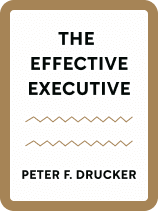

This article is an excerpt from the Shortform book guide to "The Effective Executive" by Peter F. Drucker. Shortform has the world's best summaries and analyses of books you should be reading.
Like this article? Sign up for a free trial here .
How should executives make decisions? What are some things you can do to streamline your decision-making process?
Executives’ decisions significantly affect the entire organization and its performance. Therefore, effectiveness in this area is a must. Management consultant Peter Drucker advocates a five-step approach to executive decision-making.
In this article, we’ll first introduce Drucker’s decision-making steps and compare them to other executive decision-making approaches.
The Executive Decision-Making Process
Drucker advocates this overall approach to executive decision-making:
- Don’t make a lot of decisions—make only a few important ones—because the majority of decisions are routine and can be standardized (we’ll discuss this further under Step 1).
- For the important decisions, think conceptually and strategically rather than focusing on individual problem-solving. (Shortform note: Conceptual thinking (connecting disparate ideas or abstractions) is sometimes referred to as out-of-the-box or lateral thinking.)
- Don’t try to make fast decisions, but thoroughly explore what the decision is about and what conditions it has to satisfy. (Shortform note: In recent years, there’s been greater interest in faster decision making—for example, to gain a competitive advantage or to avoid “analysis paralysis.” Various tools and methods promote rapid decision making.)
(Shortform note: In Principles, billionaire founder of Bridgewater Associates Ray Dalio offers further principles for decision-making, including:
- Systematize decision making to avoid emotions.
- Don’t take the first available option.
- Consider second- and third-order consequences.
- Make value calculations.)
| Pros and Cons of Fast Decision-Making Since Drucker’s time of writing, many other authors have analyzed the utility of fast decision making. In Blink, Malcolm Gladwell differentiates between conscious and unconscious decision making, and he argues that unconscious decisions—snap judgments or intuition—have advantages over deliberation. The process is quick, efficient, and can generate good decisions. Further, he says that while bias is a downside of unconscious decision making, you can improve your ability to make snap judgments that are smarter and less biased. In Thinking Fast and Slow, Daniel Kahneman also differentiates between the two types of thinking: He refers to unconscious thinking as System 1 thinking and conscious thinking as System 2 thinking. But in contrast to Gladwell, he’s more concerned about how often snap judgments can be wrong, and about adjusting for bias and overconfidence in our gut instincts with System 2 thinking. While Drucker advises against fast decisions above, his process for decision-making also accounts for potential bias by actively seeking dissenting views, which we discuss further below. |
Steps for Decision-Making
In this section, we’ll first introduce Peter Drucker’s executive decision-making steps and comment on his process as a whole, and then examine each step more closely and conclude with a discussion of cultivating dissent.
Step 1: Determine whether the situation requiring a decision is typical or unique. If it’s typical, it can be solved by applying a principle or rule.
Step 2: Determine the objectives the decision must meet, and the limitations or constraints (such as budget) affecting the solution.
Step 3: In considering options, focus on the right action rather than the acceptable action (this sets a benchmark before making any compromises or concessions with the decision).
Step 4: As part of the decision, determine how it will be implemented (otherwise, it’s just an intention).
Step 5: Establish a feedback mechanism for testing whether the decision works.
(Shortform note: In addition to Drucker’s five-step process for decision-making, he goes on to discuss another critical aspect of decision-making: cultivating dissent. His exploration of this aspect separately suggests he didn’t consider his five steps to be all-inclusive. Drucker didn’t further develop or refine his ideas on decision-making in later writing, as he did with other key ideas.)
| Comparison With Other Decision-Making Processes Although there are variations, business textbooks and leadership programs teach these typical steps for making decisions:Identify the decision (the problem you must solve or question you must answer).Gather the relevant information (from both internal and external sources).Identify the options.Weigh the pros and cons of each option.Choose among the options (make your decision).Take action (create a plan and assign tasks).Review your decision (ultimately, what worked and what didn’t). This process differs from Drucker’s first two steps of categorizing the decision and determining parameters, and his fourth step of focusing on right versus acceptable. These are bigger-picture elements not included in typical decision-making processes. Gallup Process The Gallup organization proposes a three-phase process encompassing 12 steps, which mostly align with Drucker’s (except for Steps 1 and 4). The phases are:Foundation: Key steps—Understand the purpose and nature of the decision required; gather relevant data; involve relevant people.Development: Key steps—Clarify roles, encourage debate, develop a plan including contingencies.Realization: Key steps—Communicate the plan and ensure follow-through; identify lessons for future decisions. Linear vs. Circular While typical decision-making processes are linear, a Harvard Business Review article argues that making decisions should be circular. The process should operate as a feedback loop in which you gather information, analyze it, factor it into your thinking, adjust your preferred solution, gather more information, and so on. Methods vs. Processes Note that decision-making methods (centered on who will make the decision) differ from the processes described above. Crucial Conversations describes four methods: command, consult, vote, and consensus. While Drucker doesn’t discuss methods, his practices for effective decision-making are aimed at executives. Therefore, he’s using a command or command-consult method, in which the executive takes charge of making decisions. |
Step 1: Is the Situation Typical or Unique?
Drucker’s first step is asking whether the situation requiring a decision is typical or unique:
- If it’s typical, the answer is to apply a principle, policy, or rule that’s worked before and will work in the future. For example, if you continually run out of certain office supplies, require employees to log the supplies they take when they leave the supply room.
- If the situation is unique, it will need a unique solution.
Step 2: What Are the Objectives and Limitations?
Drucker’s second step for making effective decisions is understanding what objectives the decision must accomplish to be considered successful. In addition, it’s important to understand any limitations that might apply. Limitations are constraints—for example, a tight budget—that limit the possible solutions. The objectives and limitations need to be clearly defined, so you can come up with an effective solution; otherwise, you won’t be sure of what you’re trying to achieve.
For example, your objective might be to speed up new product development by streamlining your company’s processes and removing bottlenecks. However, the need to support a culture of creativity and innovation (your “constraint”) would prevent you from enacting strict procedures, reporting requirements, and deadlines. So the solution might be improving teamwork and removing bureaucratic hurdles, or implementing a fast-testing method.
| Understanding the Decision’s Nature and Parameters Drucker doesn’t explain how to determine your objectives and limitations. However, other decision-making processes offer a place to start: First, define the decision (identify and understand the problem you must solve or question you must answer). To understand the problem, a Harvard Business Review article, “Are you Solving the Right Problem?”, recommends these steps:Establish the need for a solution (ask: What’s the basic need and the desired outcome?)Justify the need (What’s the benefit to the company and how will we measure it?)Put the problem in context (What solutions have we and others tried; what are the internal and external constraints on implementing a solution?)Write a problem statement (What requirements must the solution meet; how will solutions be evaluated?) Once you fully understand the problem, you’ll be better able to define your objectives and see your limitations. |
Step 3: What’s the Right Thing to Do?
Drucker’s third step in making an effective decision is, when considering options, focusing on what’s right rather than on what will be acceptable to those involved.
In many cases, you’ll have to compromise in the end. But by starting with what you think is the right solution based on the objectives and conditions, Drucker argues you’ll have a standard for differentiating good from bad compromises. A half-a-loaf compromise will still satisfy some objectives or conditions, while a poor compromise won’t satisfy any.
(Shortform note: In Never Split the Difference, Chris Voss argues against compromise as a lazy way of making a decision—because you’re accepting half a loaf without working through the risk, uncertainty, and conflict that lead to the best solutions. Further, he says compromise is more often a win-lose approach, like paying a ransom, than a win-win).
Step 4: How Will You Implement the Decision?
Drucker’s fourth step in decision-making is knowing how you’ll implement the decision. It won’t become a reality unless you build in the steps for carrying it out. He advises determining:
- Who needs to be informed of this decision?
- What needs to be done and who needs to do it?
- What capabilities do those taking the action need to have?
- What are the right measurements of success and incentives for accomplishment?
(Shortform note: Other implementation steps are: identifying outcomes and assigning a champion for each outcome, creating a tracking sheet, and following a project management methodology.)
Drucker says the fact that companies often overlook defining and carrying out the implementation steps is a reason people are often cynical about company or manager statements: They don’t expect or see follow-through. (Shortform note: A Forbes article cites lack of manager follow-through as a key reason employees don’t trust leaders.)
Step 5: How Will You Follow Up?
Drucker’s fifth and final step is getting feedback to determine whether the decision or solution is working. This step is important because decisions are sometimes wrong, or the solution needs to be adjusted due to aspects that don’t work or to changed conditions.
(Shortform note: The U.S. experience in Iraq illustrates Drucker’s point about adjusting to changing conditions. In Team of Teams, Gen. Stanley McChrystal details how the U.S. Joint Special Operations Task Force needed to drastically reorganize and adopt new tactics in response to the rise of Al Qaeda and its disruptive strategy of quick bombing strikes by small, decentralized, agile teams.)
Drucker says the best way to determine whether a solution is working is the military way: Personally observe the situation on the ground. He adds that leaders not knowing what’s really happening is a common reason activities outlive their usefulness. Therefore, leaders should constantly check plans against reality.
(Shortform note: Many project management methodologies make follow-up more structured than it was in Drucker’s time by building in a formal post-implementation review (PIR) process, including steps such as conducting a “gap analysis” that compares expectations against results.)
Cultivate Dissent
Besides his five-step decision-making process, Drucker advocates making sure you hear divergent and conflicting opinions before taking action. He says a leader should purposely create disagreement in order to fully understand the issue and the alternative solutions. Good decisions are made not by acclamation or consensus, but by dialogue and conflict, followed by the decision-maker’s judgment among the various points of view.
(Shortform note: Presumably, Drucker is again referring to strategic decisions necessarily made by leadership, rather than decisions by teams or mid-level managers who may need to get buy-in to implement decisions effectively. Consensus decision-making may be useful in teams where the decision is critical, requires everyone’s commitment, and affects the team’s long-term performance. However, there are also downsides to consensus decisions similar to those that can occur when leaders fail to cultivate dissent or when they stifle it. They fall under the umbrella of groupthink, which we’ll discuss below.)
Specifically, Drucker says disagreement is valuable because:
- It helps the decision-maker avoid succumbing to anyone’s personal interests or special pleas.
- It may provide an alternative you can fall back on if your decision turns out to be wrong (you’ll have another option you’ve already thought through).
- It can trigger creativity and insight by suggesting a different way of understanding the situation.
Perhaps the best-known historical example of a leader who welcomed dissent is Abraham Lincoln. (Shortform note: As recounted in Team of Rivals by historian Doris Kearns Goodwin, Lincoln built his cabinet around three fierce political opponents—William Seward, Salmon Chase, and Edward Bates—to ensure he would hear a range of ideas for preserving the Union and winning the Civil War. By some accounts, former President Trump was Lincoln’s polar opposite—punishing dissent and boasting about his superior knowledge and gut instincts.)
| What Is Constructive Dissent? Constructive dissent has become a more recent buzzword for encouraging disagreement. A Harvard Law blog defines it as disagreeing in a way that respectfully and productively challenges others’ views. “Collaborative” leaders must not only promote conflict but also manage it constructively—that is, by using disagreement to open up new perspectives and ensure a rigorous decision-making process. To ensure that dissent is constructive, the article recommends:Remind team members they don’t have to be right, but should be ready to disagree to help the team make a good decision.Encourage team members to share their reasoning rather than simply present data for their point of view. Ask: “What’s your logic?”Expect things to occasionally become heated: If disagreements get out of hand, encourage people to reveal the true concerns behind accusations. How to Encourage Constructive Dissent The consulting firm McKinsey & Co. instructs every new hire that they have “an obligation to dissent”—that is, the most junior person in a meeting is deemed, and expected, to disagree with the most senior person. No one is expected to agree with everything the boss says. The company believes that practicing the obligation to dissent leads to the best ideas and outcomes, and employees feel empowered in this environment. |
Make Sure a Decision Is Necessary
When you’ve thought through your objectives, encouraged disagreement, explored the alternatives, and are thus ready to make a decision, Drucker recommends that you pause for a moment and make sure a decision is necessary. He likens decisions to surgery—when you intervene, you risk upsetting the system. Unnecessary surgery and unnecessary decisions are both too risky.
- A decision is necessary when a situation will get worse if you don’t act, or an opportunity will be lost if you don’t seize it.
- A decision is unnecessary if the problem will take care of itself without action, if the situation is unimportant, or if a decision will make little difference.
- A decision may be worth making if it will improve things (if the benefit of acting outweighs the risk).
(Shortform note: Drucker’s final point about ensuring that a decision is necessary before you make one aligns with his opening argument that executives should make only a few key decisions. His motivation was to avoid wasting time on routine decisions that could be handled automatically by policies and rules. However, research since Drucker’s time of writing suggests another reason for making fewer decisions—you’ll make better ones. As you make many decisions in the course of a day, their quality declines: You suffer from decision fatigue.)
Don’t Try to Be Popular
It’s difficult to make a decision that will be unpopular, but Drucker warns, don’t be tempted to delay it for more study in order to put off the negative reaction. As an executive, you’re paid to get the right things done—which requires making effective decisions, no matter how unpopular they may be. (Shortform note: A Harvard Business Review article suggests several ways to make unpopular decisions more palatable—for example, framing the harm as a sacrifice for the greater good.)

———End of Preview———
Like what you just read? Read the rest of the world's best book summary and analysis of Peter F. Drucker's "The Effective Executive" at Shortform .
Here's what you'll find in our full The Effective Executive summary :
- How to manage yourself before you can manage others
- The five practices that anyone can learn to be more effective
- Why leaders should purposely create disagreements






